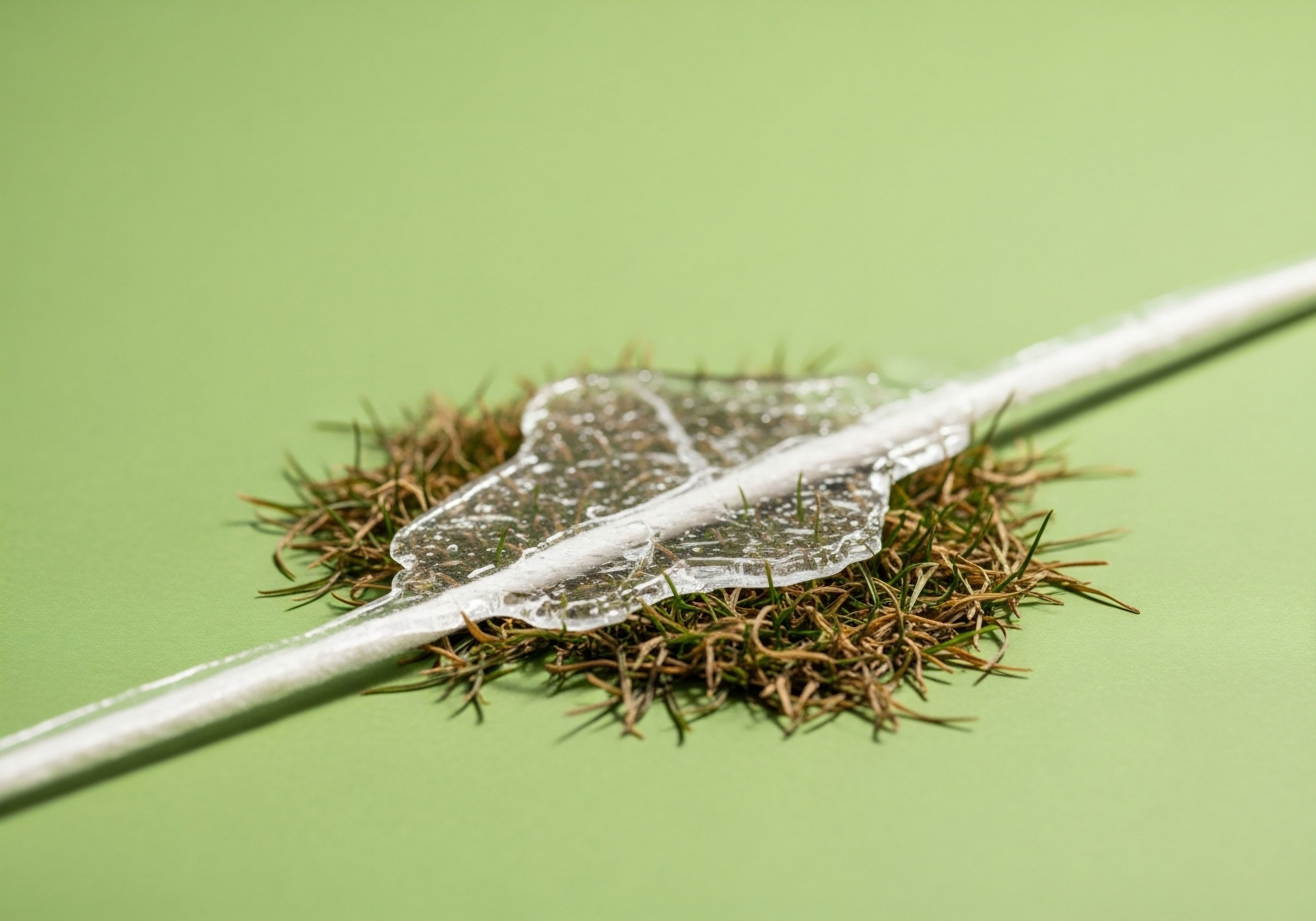

Fundamentals
You may feel a persistent sense of being unwell, a subtle yet unshakeable disharmony that blood tests and routine check-ups fail to explain. This experience of fatigue, mood fluctuations, or metabolic resistance is a valid biological reality. It speaks to a disruption within your body’s most sophisticated communication network ∞ the endocrine system.
Your hormones are the body’s internal messengers, chemical signals that travel through the bloodstream to orchestrate everything from your energy levels and mood to your reproductive health and metabolic rate. This intricate system is designed for precision and balance, operating through elegant feedback loops that maintain a state of dynamic equilibrium. When this system is functioning optimally, you feel vital, resilient, and whole.
The challenge of modern life is the constant presence of environmental hormone disruptors, also known as endocrine-disrupting chemicals (EDCs). These are substances in our food, water, air, and consumer products that possess the ability to interfere with the body’s hormonal signaling.
They can achieve this by mimicking the structure of your natural hormones, blocking hormone receptors, or altering the way your hormones are produced, transported, and metabolized. This introduces a kind of static into your biological communication channels, scrambling the messages that are essential for healthy physiological function. The body, in its wisdom, attempts to adapt, but the persistent exposure can overwhelm its capacity to maintain balance, leading to the very symptoms that can be so difficult to diagnose.
Understanding your endocrine system as a precise communication network is the first step toward protecting it from external interference.

The Body’s Internal Messaging Service
To appreciate how lifestyle changes can offer protection, one must first understand the system being protected. The endocrine system is composed of several glands, including the pituitary, thyroid, adrenals, pancreas, and gonads (ovaries and testes). Each gland produces specific hormones that act on target cells throughout the body.
Think of the pituitary gland as the central command center, receiving signals from the brain (specifically the hypothalamus) and releasing its own hormones to direct the activity of other glands. This creates a cascade of communication known as an axis, such as the Hypothalamic-Pituitary-Adrenal (HPA) axis, which governs your stress response, or the Hypothalamic-Pituitary-Gonadal (HPG) axis, which controls reproduction.
Hormones work by binding to specific receptors on or inside cells, much like a key fits into a lock. Once the hormone-receptor complex is formed, it triggers a specific response within the cell. This could be the activation of a gene, the production of a protein, or a change in cellular metabolism.
The system is regulated by feedback loops. For instance, when the thyroid gland produces enough thyroid hormone, that hormone signals back to the pituitary and hypothalamus to decrease their stimulating signals. This self-regulating mechanism ensures that hormone levels remain within a narrow, healthy range. EDCs disrupt this process by acting as illegitimate keys, either by fitting into the locks themselves or by altering the shape of the locks and keys, thereby compromising the entire system’s integrity.

What Are the Primary Routes of Exposure?
Understanding the sources of EDCs is foundational to mitigating their effects. These chemicals are pervasive in the modern environment, and exposure occurs through multiple pathways. Recognizing these pathways empowers you to make targeted choices that reduce your body’s overall toxic burden. The primary routes of exposure are ingestion, inhalation, and dermal absorption.
Ingestion is a major pathway. Pesticides used in conventional agriculture, such as atrazine, can remain on fruits and vegetables. Chemicals like Bisphenol A (BPA) and phthalates can leach from plastic food containers, water bottles, and the linings of canned goods into the food and beverages we consume.
Animals raised in conventional settings may be exposed to hormones and other chemicals that can accumulate in meat and dairy products. Even drinking water can be a source of EDCs, including runoff from agricultural and industrial sources. Inhalation is another significant route.
Volatile organic compounds (VOCs) from cleaning products, air fresheners, and furniture can release EDCs into the air we breathe. Dust particles in the home can also harbor these chemicals, making indoor air quality a serious consideration. Dermal absorption occurs when EDCs come into contact with the skin.
Many personal care products, including lotions, shampoos, and cosmetics, contain parabens, phthalates, and other synthetic chemicals that can be absorbed directly into the bloodstream. The skin, our largest organ, is a direct entry point for these disruptive compounds.


Intermediate
Strategic lifestyle modifications can profoundly influence your body’s resilience to environmental hormone disruptors. The approach involves a two-pronged strategy ∞ minimizing external exposure while simultaneously enhancing the body’s internal defense and detoxification mechanisms. This is a proactive stance, moving from a position of passive exposure to one of active biological stewardship.
Your daily choices regarding nutrition, product use, and physical habits directly impact the biochemical environment in which your hormones operate. By optimizing this internal environment, you fortify your endocrine system, making it less susceptible to the disruptive influences of external chemicals.
This process is rooted in an understanding of the body’s innate detoxification pathways. The liver, gut, kidneys, and skin are all part of a sophisticated system designed to neutralize and eliminate harmful substances. EDCs place a significant load on this system. Lifestyle interventions work by supporting the efficiency of these pathways.
For example, specific nutrients provide the cofactors necessary for enzymatic reactions in the liver that break down toxins, while a healthy gut microbiome can metabolize certain EDCs before they even enter circulation. By consciously curating your diet and environment, you are not just avoiding toxins; you are actively upgrading the biological machinery that protects you from them.

Nutritional Protocols for Endocrine Resilience
Nutrition is a cornerstone of endocrine health. The foods you consume provide the raw materials for hormone production and the essential nutrients that fuel detoxification. A diet rich in whole, unprocessed foods is foundational. This approach naturally reduces your intake of EDCs found in processed foods and packaging while increasing your intake of protective compounds.

Supporting Detoxification Pathways
The liver is the primary organ of detoxification, processing toxins in a two-phase system. Your dietary choices can directly support the efficiency of both phases.
- Phase I Detoxification ∞ This phase involves a group of enzymes known as cytochrome P450. These enzymes begin the process of transforming fat-soluble toxins into water-soluble substances. This process, however, can sometimes create intermediate metabolites that are more reactive than the original toxin. Nutrients that support Phase I include B vitamins, folic acid, and antioxidants like vitamins C and E.
- Phase II Detoxification ∞ This phase neutralizes the intermediate metabolites from Phase I and prepares them for excretion. Several pathways are involved, and each requires specific nutrients.
- Glucuronidation ∞ This is a key pathway for detoxifying BPA and other phenols. It is supported by cruciferous vegetables (broccoli, cauliflower, kale), citrus fruits, and herbs like rosemary and turmeric.
- Sulfation ∞ This pathway helps to clear excess steroid hormones and some EDCs. It requires sulfur-rich foods like garlic, onions, and eggs.
- Glutathione Conjugation ∞ Glutathione is the body’s master antioxidant and is crucial for neutralizing a wide range of toxins. Your body produces its own glutathione, but this process is supported by selenium (found in Brazil nuts), vitamin C, and whey protein.

The Role of the Gut Microbiome
The gut is a critical interface between your body and the external world. A healthy gut microbiome, the community of trillions of bacteria living in your digestive tract, performs several functions that protect you from EDCs. Certain species of gut bacteria can metabolize and neutralize EDCs, preventing their absorption.
A collection of gut microbes and their genes, known as the estrobolome, produces an enzyme called beta-glucuronidase. This enzyme can reactivate estrogens that have been detoxified by the liver, influencing overall estrogen levels. An imbalanced microbiome can lead to either too much or too little beta-glucuronidase activity, disrupting hormone balance. A high-fiber diet, rich in diverse plant foods, and the inclusion of fermented foods like yogurt and kimchi can promote a healthy and diverse microbiome.
A well-formulated diet provides the biochemical tools your body needs to neutralize and eliminate endocrine-disrupting chemicals.

Systematic Exposure Reduction Strategies
While enhancing your body’s internal defenses is vital, reducing the number of EDCs you encounter is equally important. This requires a systematic audit of your home and daily routines. The goal is to replace products containing known EDCs with safer alternatives. This process can be gradual, focusing on the changes that will have the most significant impact first.
The following table provides a structured approach to reducing exposure in key areas of your life. By focusing on these high-impact categories, you can significantly lower your daily toxic load.
| Area of Focus | High-EDC Source | Recommended Alternative | Primary EDCs Avoided |
|---|---|---|---|
| Food Storage & Cookware | Plastic containers, non-stick pans | Glass or stainless steel containers, cast iron or ceramic cookware | BPA, Phthalates, PFAS |
| Personal Care Products | Scented lotions, shampoos with parabens | Fragrance-free products, labeled “paraben-free” and “phthalate-free” | Phthalates, Parabens |
| Household Cleaners | Synthetic air fresheners, conventional cleaning sprays | Essential oil diffusers, vinegar and water solutions, natural cleaning products | Phthalates, VOCs |
| Drinking Water | Unfiltered tap water, plastic water bottles | High-quality water filter (e.g. reverse osmosis or solid carbon block), reusable glass or stainless steel water bottle | Pesticides, BPA, Heavy Metals |

How Does Physical Activity Influence Hormonal Health?
Regular physical activity is a powerful tool for promoting endocrine resilience. Its benefits extend beyond weight management and cardiovascular health, directly impacting hormonal signaling and detoxification. Exercise improves insulin sensitivity, which can be impaired by exposure to obesogenic EDCs like BPA. Improved insulin sensitivity means your body needs to produce less insulin to manage blood sugar, reducing the overall strain on your metabolic system.
Sweating is a secondary route for the excretion of certain toxins. While the kidneys and liver are the primary organs of detoxification, studies have shown that some EDCs, including BPA and heavy metals, can be eliminated through sweat. This makes activities that induce sweating, such as vigorous exercise or sauna use, a valuable component of a comprehensive detoxification strategy.
Furthermore, physical activity helps to modulate the HPA axis. It can blunt the cortisol response to stress over time, making your body more resilient to the physiological effects of chronic stress, which can otherwise amplify the negative impacts of EDCs.


Academic
A sophisticated understanding of how lifestyle interventions mitigate the effects of EDCs requires a deep examination of the gut-hormone axis. The gastrointestinal tract is a primary site of interaction with ingested EDCs, and the gut microbiome functions as a distinct and highly active endocrine organ.
This microbial community engages in a complex biochemical dialogue with the host, influencing everything from nutrient absorption and immune function to the metabolism of xenobiotics, including EDCs. The integrity of this axis is paramount for maintaining systemic endocrine homeostasis. Disruptions at this level can precipitate a cascade of metabolic and hormonal dysregulation throughout the body.
Exposure to EDCs can induce a state of dysbiosis, characterized by a shift in the composition and function of the gut microbiome. This can lead to several adverse consequences. First, a reduction in microbial diversity can impair the microbiome’s capacity to metabolize EDCs, potentially increasing their bioavailability and toxicity.
Second, dysbiosis is often associated with a compromise of the intestinal barrier. An increase in intestinal permeability allows for the translocation of bacterial components, such as lipopolysaccharide (LPS), from the gut into systemic circulation. This triggers a low-grade, chronic inflammatory state, which is a known contributor to insulin resistance, metabolic syndrome, and further endocrine disruption. Therefore, lifestyle strategies that support a eubiotic gut environment and maintain intestinal barrier integrity are of critical clinical importance.

The Microbiome as a Xenobiotic Processing Hub
The gut microbiome possesses an extensive enzymatic repertoire capable of metabolizing a wide range of xenobiotics. These microbial biotransformations can have significant consequences for the host. In some cases, the microbiome can detoxify EDCs, converting them into less harmful metabolites that are more easily excreted.
In other instances, however, microbial metabolism can result in bioactivation, producing metabolites with greater endocrine-disrupting activity than the parent compound. The balance between detoxification and bioactivation is influenced by the specific composition of an individual’s microbiome.
An important example of this is the role of the estrobolome in estrogen metabolism. As previously mentioned, microbial β-glucuronidase enzymes can deconjugate estrogens that have been inactivated by the liver, releasing them back into circulation. Many EDCs, particularly phytoestrogens and xenoestrogens like BPA, are also substrates for these enzymes.
An altered gut microbiome with high β-glucuronidase activity could therefore increase the body’s total exposure to estrogenic compounds, both endogenous and environmental. Lifestyle factors, particularly diet, play a dominant role in shaping the microbiome’s enzymatic capacity. A diet high in fiber and polyphenols tends to foster a microbial community that supports healthy estrogen metabolism, while a diet high in processed foods and low in fiber can have the opposite effect.
The gut microbiome acts as a critical gatekeeper, metabolizing environmental chemicals in ways that can either protect or harm the host’s endocrine system.

EDC-Induced Dysbiosis and Systemic Inflammation
The link between EDCs, gut dysbiosis, and systemic inflammation represents a key mechanism through which these chemicals exert their pathological effects. Many EDCs have been shown to alter the relative abundance of major bacterial phyla, such as the ratio of Firmicutes to Bacteroidetes, which has been associated with obesity and metabolic dysfunction. For example, exposure to triclosan, an antimicrobial agent found in some consumer products, has been shown to decrease the population of Bifidobacterium, a beneficial genus of bacteria.
This dysbiosis contributes to the breakdown of the intestinal barrier. The tight junctions between intestinal epithelial cells, which regulate the passage of substances from the gut into the bloodstream, can become compromised. This allows for the leakage of LPS, a component of the outer membrane of Gram-negative bacteria.
When LPS enters the circulation, it binds to Toll-like receptor 4 (TLR4) on immune cells, triggering a pro-inflammatory cascade. This chronic, low-grade inflammation is a central driver of insulin resistance, a hallmark of type 2 diabetes and a common consequence of EDC exposure. By promoting a healthy microbiome and strengthening the gut barrier through diet (e.g. fiber, probiotics, prebiotics) and stress reduction, lifestyle interventions can directly counteract this inflammatory pathway.
The following table details the effects of specific EDCs on the gut microbiome and the subsequent health implications, drawing from current research.
| Endocrine Disruptor | Observed Effect on Gut Microbiome | Potential Health Consequence | Supporting Lifestyle Intervention |
|---|---|---|---|
| Bisphenol A (BPA) | Alters the Firmicutes/Bacteroidetes ratio; may increase Bifidobacterium spp. in some contexts, leading to metabolic changes. | Increased risk of metabolic disorders, obesity, and altered estrogen signaling. | High-fiber diet, consumption of cruciferous vegetables to support glucuronidation. |
| Phthalates | Can modify microbial diversity and alter the ratio of key bacterial phyla. | Associated with reproductive health issues and metabolic dysfunction. | Avoidance of plastics and scented products; dietary intake of probiotics. |
| Pesticides (e.g. Chlorpyrifos) | Reduces microbial diversity and abundance of beneficial bacteria like Lactobacillus. | Neurodevelopmental effects, increased intestinal permeability, and inflammation. | Consumption of organic produce; intake of polyphenol-rich foods (berries, green tea). |
| Triclosan | Decreases microbial diversity, specifically reducing Bifidobacterium populations. | Promotes gut inflammation and may exacerbate colitis and metabolic syndrome. | Avoidance of products containing triclosan; consumption of fermented foods. |

References
- Stárka, L. Dušková, M. & Hill, M. (2019). Endocrine Disruptors and Gut Microbiome Interactions. Physiological Research, 68(Suppl 4), S459 ∞ S470.
- Marques, C. et al. (2020). Endocrine Disruptors in Food ∞ Impact on Gut Microbiota and Metabolic Diseases. Nutrients, 12(4), 1133.
- Carr, K. (2016). 9 Ways to Decrease Your Exposure to Endocrine Disruptors. Kris Carr.
- Cioana, C. et al. (2022). Endocrine-Disrupting Chemicals, Gut Microbiota, and Human (In)Fertility ∞ It Is Time to Consider the Triad. International Journal of Molecular Sciences, 23(21), 12756.
- National Institute of Environmental Health Sciences. (2023). How can you reduce health effects of endocrine-disrupting chemicals?. NIEHS.

Reflection
The information presented here provides a map of the biological terrain, illustrating the profound connections between your environment, your choices, and your hormonal vitality. This knowledge is the starting point of a personal journey. Your own body is a unique ecosystem, with its own history, genetic predispositions, and current state of balance.
The path toward reclaiming and sustaining your health is one of continuous learning and self-awareness. Consider your daily routines, your patterns of eating, and your sources of stress. Where are the points of leverage? What small, sustainable changes can you implement today that will begin to shift your internal environment toward one of resilience and health?
This journey is about cultivating a deeper relationship with your own physiology, learning to listen to its signals, and providing it with the foundational support it needs to function with clarity and strength.

Glossary

endocrine system

phthalates

bpa

parabens

lifestyle interventions

gut microbiome

cytochrome p450

glucuronidation

estrogens that have been

estrobolome

gut-hormone axis

microbial diversity

intestinal permeability




